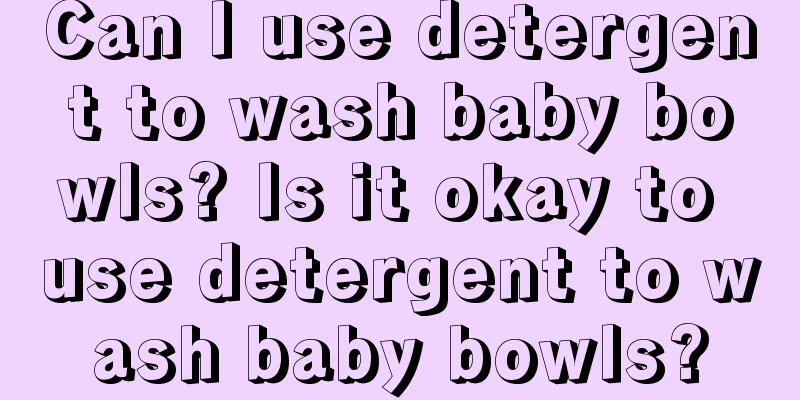Can I use detergent to wash baby bowls? Is it okay to use detergent to wash baby bowls?

|
When parents clean their baby's utensils, they worry that the baby's products are not clean enough, and they also worry that using chemical cleaners will be harmful to the baby's health. Can baby products be cleaned with detergent? Here is the answer for you. Can I use detergent to wash baby bowls?The bowls that babies eat from can also be cleaned with detergent. When cleaning, just make sure the bubbles are clean. However, it is still recommended to clean the baby's bowls regularly so that bacteria will not easily grow. This will be more beneficial to the baby's health. Is dishwashing liquid toxic? The main ingredients of dishwashing liquid are: sodium linear alkylbenzene sulfonate, sodium fatty alcohol polyoxyethylene ether sulfate, sodium dodecyl sulfate, sodium olefin sulfonate, etc. These ingredients are low-toxic or even non-toxic and harmless to the human body, but there is still a certain risk if they are swallowed directly or left on tableware. How to clean baby bowls Babies' diet is generally light, and there is no greasy food that is difficult to wash off. Generally speaking, hot water is enough to clean the bowl. The specific method is to wash it once with hot water, and then scald it again with boiling water. Tips for using dishwashing liquid1. Do not use the original solution. Even if you use the 3 yuan bottle of non-diluted detergent, you should dilute it before use. This can greatly reduce the concentration of residues. For the 3 yuan bottle of White Cat, the amount of the original solution of one bottle cap can be diluted into another bottle. 2. After using the diluted solution to clean the oil stains, rinse it with clean water immediately. Do not contact it with detergent again, and do not soak it in the diluted detergent to reduce the contact time. 3. Rinse at least twice, this is the minimum. Store the dishes separately after washing and avoid splashes and drips of detergent. If you stack dishes, it is equally important to clean the bottom and inside of the dishes, because the upper dish is stacked inside the lower dish. In short, the cleaning ability of chemical detergents mainly comes from surfactants. Because surfactants can reduce surface tension, they can penetrate into the fiber gaps that even water cannot penetrate, and squeeze out the dirt hidden in the fiber gaps. Chemical detergents squeeze into these gaps, making it difficult for water to clean them. Similarly, surfactants can also penetrate the human body. About 0.5% of detergents that stick to the skin enter the blood. If there is a wound on the skin, the penetration rate will increase by more than 10 times. Chemical detergent toxins that enter the human body can reduce the concentration of calcium ions in the blood, acidify the blood, and make people easily tired. These toxins also reduce the liver's detoxification function. The toxins that should have been excreted from the body accumulate in the body, causing people's immunity to decline, liver cell lesions to worsen, and easily induce cancer. What kind of detergent can't be used?According to relevant national laws and regulations, formaldehyde cannot be added to dishwashing liquid. However, some small manufacturers have to use formaldehyde as a preservative to ensure that the dishwashing liquid does not deteriorate because the raw materials, production process, sanitary conditions, etc. do not meet the requirements. Therefore, there are two main reasons for the excessive formaldehyde: one is that the company does not control the quality of the raw materials enough, and the other is that some illegal companies illegally add formaldehyde in order to pursue the washing effect. In addition to formaldehyde, methanol is also added to promote the dissolution of aqueous and organic phase substances. We are more familiar with methanol, the main component of fake liquor. It is toxic and can cause methanol poisoning after drinking. It has a great impact on the human nervous system and blood system. It can cause toxic reactions when ingested through the respiratory tract, digestive tract or skin. Methanol vapor can also damage the human respiratory tract. Therefore, instead of questioning whether dishwashing liquid has problems, it is better to supervise the companies and put an end to such irresponsible practices towards consumers, which can protect our own safety. The lack of health and safety awareness among product manufacturers and operators, lax market supervision or ineffective crackdown after investigation and punishment have allowed lawbreakers to take chances and knowingly commit crimes. Acute toxicity tests on dishwashing liquids have shown that they are low-toxic substances and are basically non-toxic at actual concentrations, but if taken in large quantities by mistake, they are likely to be slightly toxic and cause mild or moderate poisoning. Of course, I am referring to dishwashing liquids produced by regular manufacturers. |
<<: How old can babies eat mooncakes? Will babies get sore throats after eating mooncakes?
>>: Can babies eat oats? At what age can babies eat oats?
Recommend
How to relieve breast engorgement? Pay attention to your diet when breast engorgement occurs.
Breast engorgement is a problem that every mother...
What causes baby's diarrhea? What should I do if my baby has diarrhea?
When I was changing my baby's diaper, I found...
Do babies with diarrhea need zinc supplements? Do babies with diarrhea need to change milk powder?
Usually babies' stomachs are very fragile and...
How to prevent and treat hand, foot and mouth disease in children
Hand, foot and mouth disease seriously threatens ...
What are the symptoms of baby eczema? What should I do if my child has cold hands and feet?
The skin of newborn babies is tender and sensitiv...
What are the common diseases of babies in summer? Introduction to common diseases of babies in summer
What are the common diseases of babies in summer?...
What causes a baby's stuffy nose? What should I do if my baby spits up milk due to a cold?
Nasal congestion is the most common symptom of a ...
Sharing my personal experience on things not to do during pregnancy
Many people will tell us that we cannot do this o...
How to bathe your baby correctly? What is the water temperature for bathing your baby?
Giving your baby a bath is a difficult and arduou...
Why do babies like to bite their nails? What is going on when babies bite their nails?
Many mothers are very sensitive to all kinds of b...
How to care for your baby's fontanelle? When will your baby's fontanelle close?
The fontanelle grows on the baby's head and i...
Can hawthorn reduce milk production? How much hawthorn should I eat to reduce milk production?
Hawthorn is rich in vitamins and has a very good ...
Will too many toys hinder children's intellectual development?
Children are the treasures of their parents. Pare...
Will the baby's spitted milk flow into the ears? What should I do if the baby's spitted milk flows into the ears?
Spitting up milk is a common phenomenon in babies...
What should I do if my baby gets angry after eating milk powder? What should I do if my baby gets angry after eating milk powder?
Many babies have dry stools and increased feces i...









